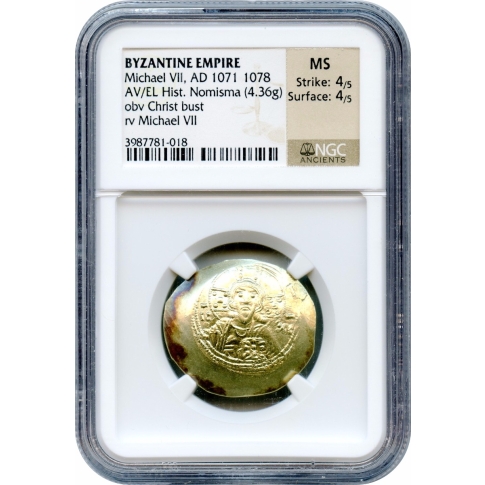Byzantine Empire - AD1071-1078 Michael VII AV/EL Histamenon Nomisma NGC MS
Byzantine Empire – Overview
Period of existence – 330 A.D. to 1453
Spanning over a millennium, the “Byzantine” Empire was one of only two ancient civilizations to stretch from antiquity to modernity (China being the other). The Empire took its name from the ancient Greek colony of Byzantium, founded by a fellow named Byzas. In 330 A.D., Roman emperor Constantine the Great declared the foundation of a “new Rome” on the site of Byzantium – a city to be named Constantinople, which became the capital of an “eastern Roman” empire that would exist for centuries after the fall of the western Roman empire in 476 A.D. Having been under siege by Germanic invaders like the Visigoths throughout much of the century, by this time the western Roman empire really only encompassed Italy, the empire reduced to only a fraction of its former territory by virtue of constant warfare and invasion.
Although Constantine himself ruled over a unified empire upon becoming emperor in 307 A.D., by the time of his death in 337 A.D., its’ unity was disintegrating. In 364, Emperor Valentinian II divided the empire officially, setting himself up as the Western emperor and his brother Valens as the Eastern emperor. As the century progressed into the 400’s, with the aforementioned barbarians perpetually at the gates, Germanic tribes led by Odovacer overran Rome’s last defenses, overthrowing the last of the Roman emperors, Romulus Augustulus. Odovacer proceeded to declare himself King of Italy -the Roman Empire in the west was finished. The Eastern Empire was another story entirely.
The East Lives On
The Eastern half of the Roman Empire proved to be much less prone to external attack, mostly due to geography. Constantinople was located on the European side of a strait, the Bosporus, which linked the Black Sea to the Mediterranean. This location on the Bosporus made it an ideal capital in several ways – as an ideal transit hub for east-west trade, and for maintaining its defenses. Compared with other medieval states, it had excellent administration and was able to maintain generally good economic control over its finances and muster enough manpower to maintain its defense and security. As a result, the Eastern Roman, or “Byzantine” empire was able to survive for nearly a thousand years after the fall of Rome. It had numerous highly skilled and efficient rulers in the centuries after Constantine (Justinian I, Heraclius), as well as some not so illustrious ones (Phocas, Romanus III), but the Byzantine Empire managed to maintain a level of stability and economic prosperity for its citizens that became the envy of the medieval world.
Glory Days
Justinian I, who assumed power in 527, was the first of the great Byzantine emperors, ruling the empire at its geographical apex and building some of the greatest monuments of the empire, among them the Hagia Sophia in Constantinople. This first “golden age” of the empire would not be repeated in a grand sense until the 10th and 11th centuries, when the Macedonian dynasty begun by Basil (867 to 886) would prove to be the greatest that the empire had ever known, with advances in economy, jurisprudence and geographical expansion. The empire thrust forward to the Euphrates, regaining much of the lost territory of the past few hundred years. The Byzantine Empire also oversaw a rise in the role of women in government, as Empresses Irene (797 to 802) and Zoe (1041) became sole rulers in their own right, something the world had not previously known for a major kingdom.
The Beginning of the End – the Palaeologi
Beginning with Michael the VIII, of the Palaeologus dynasty, in 1261, the once mighty Byzantine economy began to show signs of serious decline. Even though Michael himself was a competent and dynamic leader and restored much of the lost glory of the empire, Turkish invasions and the costs of the Crusades began to take their toll. (Constantinople itself was looted and sacked after the 4th Crusade in 1204). After a few decades of somewhat limited autonomy as a Turkish vassal state, in 1453 an Ottoman army led by Sultan Mehmed II stormed and overran Constantinople, with the last emperor, Constantine XI dying in battle. The decline and fall of the Byzantine Empire was now complete, even though the culture they established would continue on, influencing the Renaissance and Western intellectual traditions even to the present day.
| Grading Service | NGC |
|---|---|
| Year of Issue | NONE |
| Grade | MS60 |
| Ancient Year Range | 1001-1100 AD |
| Denom Type | Ancient |
| Numeric Denomination | AV/EL Histamenon Nomisma |
| Mint Location | NONE |
| Designation | NONE |
| Circ/UnCirc | Uncirculated |
| Strike Type | Business |
| Holder Variety | Strike 4/5; Surface 4/5 |
| Grade Add On | NONE |
| Holder Type | N/A |



